Abstract
According to the Intergovernmental Panel on Climate Change (IPCC) 5th Assessment report, energy-efficient appliances can reduce global electricity consumption even though there is an expected increase in the number and ownership of appliances. The International Energy Agency (IEA) expects a high increase in energy efficiency in traditional appliances (refrigerators, washing machines, television, etc.), and in the number of new appliances installed (also called plug loads). The bibliometric study of publications related to energy-efficient appliances carried out in this paper shows that research on this topic is growing in developed regions (North America and Europe) and even more in some developing regions (Asia Pacific) with a high emphasis on China and India. The results indicate that, in general, policies are always implemented before the core of publications on the topic, with time spans ranging from 3 to 30 years. However, the trend seems to be changing with publications related to new appliances where the core research happens shortly after or in parallel to the establishment of policies.
1. Introduction
In order to achieve the objectives targeted by the sustainable development goals, immediate actions are necessary. Moreover, to reach deep decarbonization, different strategies should be adopted, including the use of clean energy sources and efficient energy conversion and management approaches [1]. However, special attention should be given to the building sector, which accounts for nearly the 40% of the global energy consumption and emission to the atmosphere [2]. According to the IEA (International Energy Agency), appliances are responsible for 17% of final electricity use in buildings [3]. Furthermore, the energy consumption of building appliances shows an increasing trend over the last 20 years with a small growth in highly developed regions such as North America and the European Union, and high growth of four to eight times the values reached in 2000 in regions such as China, India and the Middle East (Figure 1). Nowadays, only one-third of appliance energy use today is covered by mandatory performance standards. The IPCC (Intergovernmental Panel on Climate Change) 5th Assessment report stated that energy-efficient appliances can reduce the electricity use expected due to the proliferation of appliances types and their increased ownership and use [4] and policy measures such as appliance standards with strong energy efficiency requirements are available to help achieve this objective. The United States, European Union, China, India, Brazil, Australia, Mexico, South Africa, and Malaysia, nine of the countries that have been operating the longest EES&L (Energy Efficiency Standards and Labelling) programs reduced annual electricity consumption in 2018 by 1580 TWh. This represents the same order of magnitude as the total electricity generated by solar and wind energy in those countries [5].

Figure 1.
Energy consumption of building appliances by region. Data extracted from IEA [3].
Energy intensity improvement in appliances such as refrigerators, washing machines, TVs, and computers has counteracted the substantial increase in ownership and use since the year 2000. Moreover, digitalization is essential in buildings that support more energy-efficient systems.
Table 1 shows the worldwide final energy used by a variety of appliances and the contribution of each one of the different drivers (activity, structure, and efficiency) in the period 2000–2017. The activity driver is given by a change in the overall level of activity that drives energy consumption (i.e., population); the structure effect reflects a change in the mix of activities within a sector (i.e., appliance stocks per person); and the energy efficiency shows changes in sub-sectoral energy intensities, that is, in energy used per unit of activity (i.e., appliance energy per appliance stocks). It is clear traditional appliances (refrigerator, freezer, television, etc.), have a very low impact on the total energy intensity (understood as the quantity of energy required per unit) growth, which is due to the new appliances, also called plug loads. On the other hand, energy efficiency will have its maximum energy efficiency increase in the traditional appliances.

Table 1.
Worldwide energy intensity improvements in appliances in the period 2000–2017 [6].
Cabeza et al. [7] studied the ownership of appliances in different countries (Figure 2). Most white goods (refrigerators, freezers, and washing machines) ownership in Europe reached saturation already in the 1970s, and other developed countries of the world (Japan and USA) show ownership higher than 100%. Developing countries show very diverse results in ownership of the different appliances, with a few already showing saturation (such as refrigerators, washing machines, and televisions (TVs) in China) and in others a slow growth (such as refrigerators and TVs in India).
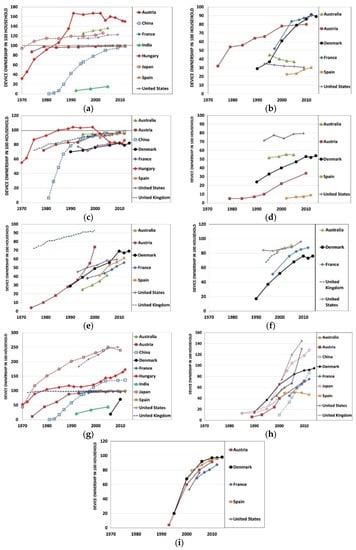
Figure 2.
Appliances ownership. (a) Refrigerators; (b) freezers; (c) washing machines; (d) clothes dryers; (e) dishwashers; (f) microwave ovens; (g) televisions; (h) computers; (i) mobile phones. Reprinted with permission from Ref. [7]. Copyright 2018, Elsevier.
In order to identify the trends of a certain topic, bibliometric analysis techniques were recognized as an interesting approach to defining the state of the art as well as identifying research gaps using both a quantitative and qualitative approach.
The aim of this paper is to evaluate how the energy efficiency in appliances was studied in the world, and the main research question is to evaluate if there is a penetration of this concept in the research of countries all over the world and if there is a correlation with energy policies and the EES&L programs. The appliances considered in this paper are presented in Table 2. The results of this paper can be used by researchers to have a clearer picture of research trends and to understand the main pathways of the development of policies related to appliances in buildings.

Table 2.
Appliances considered in this study.
2. Materials and Methods
Bibliometric analysis and bibliographic mapping were carried out following the methodology presented in Figure 3. Both studies are complementary to achieve a correlation of data based on an initial query formulation of the target topic, the energy efficiency of appliances. Four main databases are recognized for completing bibliometric analyses: Dimensions, Google Scholar, Web of Science (WoS), and Scopus. In this study, the Scopus database was selected as it provides more comprehensive content focused on science and technology disciplines [8].
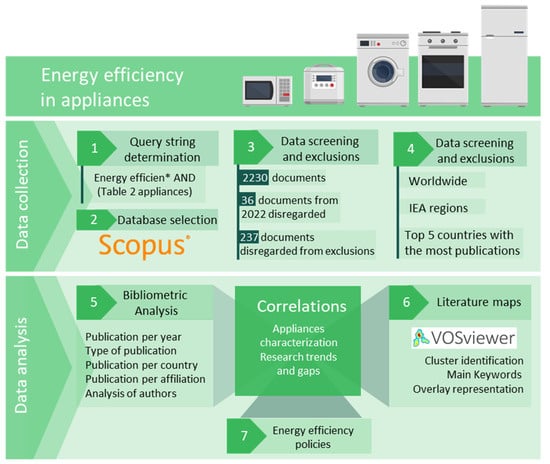
Figure 3.
Methodology followed in the bibliometric analysis.
This study was carried out with the following query:
KEY ((“energy efficien*”) AND (“Refrigerator” OR “Television” OR “Freezer” OR “Video recorder” OR “Fridge-freezer” OR “Laptop” OR “Washing machine” OR “Wet appliance” OR “Desktop” OR “Clothes dryer” OR “Phone” OR “Dryer machine” OR “Record player” OR “Dishwasher” OR “DVD” OR “Oven” OR “Media centre” OR “Cooker” OR “Media player” OR “Gas hob” OR “Gas cooker” OR “Printer” OR “Electric hob” OR “Electric cooker” OR “3D-printer” OR “3D print*” OR “Kitchen smoke extractor” OR “Console” OR “Games machine” OR “Tablet” OR “Consumer electronic” OR “Microwave oven” OR “Coffee maker” OR “Vacuum cleaner” OR “Electric mixer” OR “Hand blender” OR “Rice cooker” OR “Kitchen robot” OR “Hair dryer” OR “Electric toothbrush” OR “Towel drying rack” OR “Towel dryer” OR “Toaster” OR “Electric fan” OR “Ceiling fan” OR “Portable fan”) AND NOT (“combustion” OR “Computer aided engineering” OR “static mixer” OR “industrial refrigeration” OR “air duct” OR “biomass” OR “casting” OR “cryogen*” OR “drying method” OR “industry*” OR “kinetic model” OR “kiln” OR “printing technolog*” OR “polygeneration” OR “semiconduct*” OR “transportation sector” OR “corrosi*”)) AND (EXCLUDE (PUBYEAR, 2022)).
After a thorough review of the publications, a total of 273 documents were excluded from the query, 36 due to being published in 2022 and 237 for not being related to the topic. As a result, the number of publications to be analyzed was clearly identified. Figure 3 shows that the query has 1957 documents.
Once all the information and references were downloaded from the specified database, the next stage was to proceed with the data analysis. This part was divided into two sections, the results of the bibliometric analysis and the representation of the literature map. In the bibliometric analysis, the extracted data were plotted in different chart types, where there are denoted assessments, as shown in Figure 3. On the other hand, the present work encompasses a literature map analysis that was performed by taking the reference information from Scopus. These data were exported to a software tool, called VOSviewer [9]. The selected software has two visualization options, grouped clusters or an overlaid timeline representation. The latter visualization shows the analysis of the average publication date of the keywords, being able to recognize the most recent keyword in the field. The relationship between keywords, authors, and countries was studied. The last step was to analyze the correlation between the statistics of the bibliometric analysis, the literature maps, and the implementation of national standards in each region analyzed.
The study was done with different geographic coverage. First, all publications worldwide are considered. Then all countries were aggregated into IEA regions [10]. The top five countries with more publications were also considered and used to illustrate the analyses carried out (United States, China, India, United Kingdom (UK), and Germany).
The world population was obtained from the United Nations 2019 Revision of World Population Prospects [11].
3. Results
3.1. Global Bibliometric Analysis
The present search was carried out in February 2022, which is why the time frame was established in the query, considering all historical publications on the subject up to the year 2021.
Figure 4a shows that around 50% of publications on the topic are articles/papers and the other 50% are conference papers, with a small number of reviews and books. The same distribution is also followed individually by all countries included in the study. Moreover, when analyzing the number of publications by region, Figure 4b shows that the Asia Pacific and Europe show similar values, being the regions with the highest number of publications. Followed by North America with 35% fewer publications. When analyzed by country, the United States is the country with the highest number of publications, followed by China.
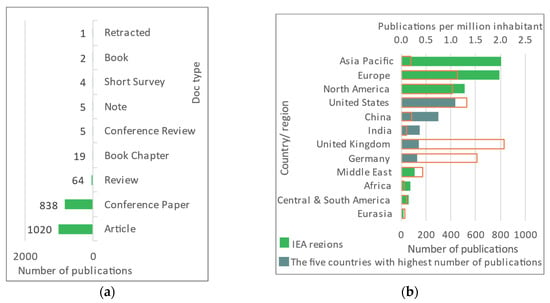
Figure 4.
Distribution of documents by (a) type of documents (b) country/region of publication and in the orange bars publications per million inhabitants.
When the population of each country/region is also taken into account, the United Kingdom stands out with more than two publications per million inhabitants, followed by Germany and the United States. Regionally, Europe and North America show the highest values with one publication per million inhabitants.
The trends in the number of publications are shown in Figure 5. The figure shows that energy efficiency in appliances was already a topic of research in the 1970s, with continuous interest in the peer-reviewed literature until today. However, in 2007 the number of publications started to grow (from 51 documents in 2007 to 127 in 2011 to 166 in 2021). The same trend can be seen worldwide and for each country/region considered. Interestingly, the region that started publishing on this topic was North America, followed by the Asia Pacific and Europe. The growth in the number of publications was very high in Asia Pacific, Europe, and North America in the period 2007–2011. Then, somehow publications stagnated in North America, continuing to grow in Europe and even more so in the Asia Pacific.
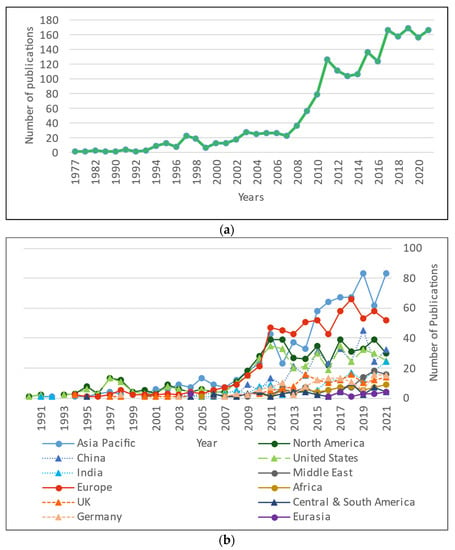
Figure 5.
Trends in the number of publications in the area of study (a) worldwide (b) per country.
Figure 6 shows the relationship between the countries’ publications obtained with VOSviewer. When considering countries aggregated in the IEA regions Figure 6a, the network highlights that Europe, Asia Pacific, and North America are the regions with the oldest research publications, showing more recent interest in the remaining regions. This is evidence that this topic has spread from developed to developing regions.
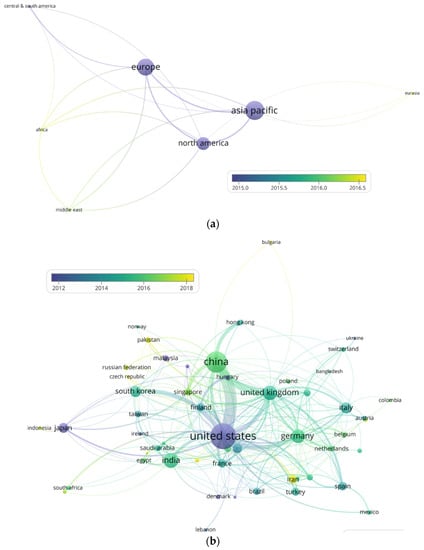
Figure 6.
Countries’ relationships (a) considering the IEA regions (b) considering all countries with publications.
The analysis of country relationships in Figure 6b in accordance with Figure 6a shows that the United States, Japan, and Denmark started research on this topic at an earlier stage. The most recent countries to start research on this topic are Iran, Pakistan, United Arab Emirates, Qatar, and the Czech Republic. Moreover, it is interesting to see the strong link between the United States, China, and the United Kingdom.
The analysis of the authors with a higher number of publications (Table 3) shows that R. Saidur from Sunway University of Malaysia is the author with the most documents (12 publications). The most-cited article by R. Saidur (published in 2002) is an experimental analysis of two domestic refrigerators to investigate the effect of variables such as temperature, thermostat setting positions, and door opening on energy consumption. His research reveals that room temperature has the greatest effect on energy consumption, followed by door opening [12]. Furthermore, the most recent publication by R. Saidur (2021) reports on a thermodynamic analysis of a domestic refrigerator using the nano-refrigerant Al2O3. The results showed that the energy consumption of the refrigerator was reduced by approximately 2.69% when using 0.1% Al2O3 [13].

Table 3.
Authors with more publications in the field of study.
The second author with the most publications is J.K. Nurminen, from the VTT Technical Research Centre in Finland. His most cited publication (published in 2009) deals with a burst content sharing mechanism for energy-constrained mobile devices. The results showed that compared to standard BitTorrent technologies the energy-limited peers can achieve 50% energy savings without significantly affecting the download speeds of regular peers [14]. The most recent publication by J.K. Nurminen (2013) deals with characterizing the energy impact of concurrent network-intensive applications on mobile platforms. Among its findings is that running multiple network-intensive applications concurrently can significantly improve energy efficiency, up to 2.2 times compared to running them separately [15].
H.H. Masjuki is the third most published author, sharing both his most-cited publication and his most recent publication with R. Saidur.
The three authors mentioned above show a high consistency in their research line being their most-cited and most recent works on the same research topic. All of them are of high relevance for improving the efficiency of appliances. It is interesting to highlight that Table 3 does not follow the same trend of countries as shown in Figure 4 and Figure 5. Finally, the h-index of the searched papers shows that for most of the authors the papers on the topic had a high impact.
When analyzing where the authors publish and how these documents are grouped (Figure 7), the journal with the highest number of publications is Applied Energy, showing that energy efficiency in appliances is very related to research in energy systems. Table 4 shows that all journals used have a high impact (being classified in the first 25% of most-cited journals–Q1) except for the journal Energy Efficiency, probably used because of the relation between the journal scope and the topic of study. It is interesting to see that none of the journals are open access and the documents are mostly related to Engineering, Computer Science, and Energy fields.
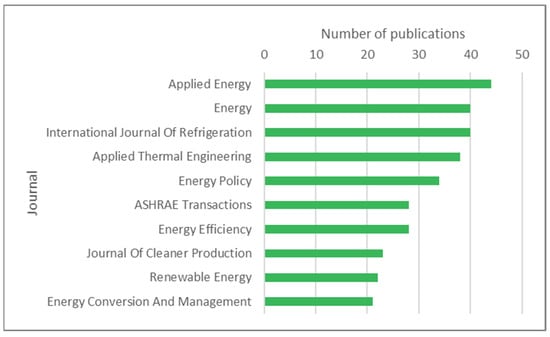
Figure 7.
Journals where the documents are published.

Table 4.
The journals most used and their impact.
3.2. Analysis of Keywords
Figure 8a shows details of the co-occurrence map of the search considering worldwide publications. The map is divided into five clusters, the first cluster in red encompasses keywords related to digital applications such as “personal computer”, “digital television”, “wireless communication”, and “smartphone”. In this cluster, we can find research studies on approaches to reduce the energy consumption of wireless networks, both at the domestic and industrial levels [10,16,17,18]. A special emphasis is placed on improving the energy efficiency of the new generation of devices connected to the Internet of Things (IoT), including smartphones [19,20,21,22].
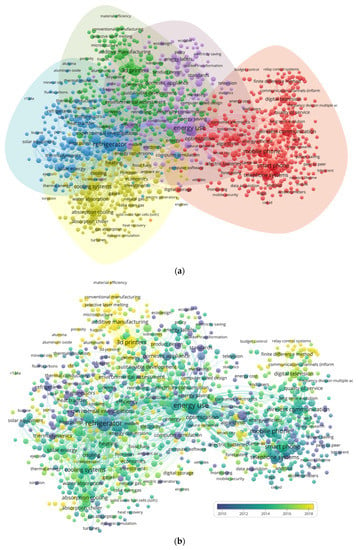
Figure 8.
Efficiency in appliances co-occurrence keyword network, (a) grouped in clusters, where each color groups keywords in a cluster, (b) overlay visualization, where color indicate year of publication.
The next cluster in yellow focuses on heating and cooling appliances with keywords such as “heating”, “cooling systems”, and “absorption cooling”. In this cluster, we can also find the keywords “carbon dioxide emissions” and “renewable energy” which demonstrate the efforts being made to transform the energy demand matrix of these highly energy-intensive appliances into renewable energy [23,24,25,26].
The third cluster in blue gathers the keywords related to refrigeration, with keywords such as “refrigeration”, “refrigerants”, “food preservation”, “thermodynamics”, and “solar energy”. The latter with a strong link to “absorption cooling” from the yellow cluster. This cluster comprises a wide range of experimental studies focused on improving the efficiency [27,28,29] and reducing the cost [30,31] of vapor compression systems.
The fourth cluster gathers studies that pursue more efficient alternatives to the current manufacturing systems [32,33,34], therefore its main keywords are “3d printers”, “manufacture”, “additives” and “additive manufacturing”. This cluster also contains the keywords “environmental assessment” and “sustainable development” closely related to the first keywords mentioned in this cluster and to “refrigerator” from the yellow cluster.
Finally, the purple cluster comprises the studies related to the use of energy in appliances and the effect of standards and policies [35,36,37,38]. Among the most relevant keywords, we can find “domestic appliances”, “energy policy”, “standards”, “energy labels”, “energy use”, and “energy savings”.
The overlay visualization Figure 8b shows that studies with the oldest average number of publications focus on refrigerators (average year of publications 2010), and washing machines (2008), with a strong link to refrigerants (2010), compressors (2008), standards and energy policy (2006 and 2011), respectively. Next is the keyword “domestic appliance” in (2011) related to energy label (2012), and the keyword “personal computer” (2011) related to “mobile device” in 2012 and wireless communication (2013). The figure shows that the most recent studies focus on IOT (2018), and 3D printers (2018), the latter with high attention from the scientific community representing 15% of the total publications captured by this study.
4. Discussion and Conclusions
According to the IEA TCP 4E (International Energy Agency Technology Collaboration Programme Energy Efficiency End-use Equipment), between 2004 and 2014, the average sales-weighted efficiency of new refrigerators in the EU improved by 3.4% per year, resulting in a 25% reduction in energy consumption. In Australia, the sales-weighted average energy efficiency of refrigerators increased 2.7% per year between 1993 and 2014, and 2.2% for freezers. Figure 9 shows that, in developed countries, the average sales-weighted efficiency of new refrigerators increased between 2% and 4% per year. This can be correlated with the exponential increase in publications on the topic worldwide from the late 1990s to 2011 Figure 5a. In other appliances, the range of improvement per year between the different countries is higher, but also the best energy efficiency is higher. For example, for TVs, the range varies from 1% in Switzerland to 13% in Japan. This trend cannot be directly correlated with the number of publications on the topic. Indeed, it can be correlated to the lack of standards regulating the energy efficiency of brown goods in a large number of countries (Figure 10).

Figure 9.
Annual efficiency improvement rates for different appliances in different countries, up to 2014, calculated for different time frames [39].
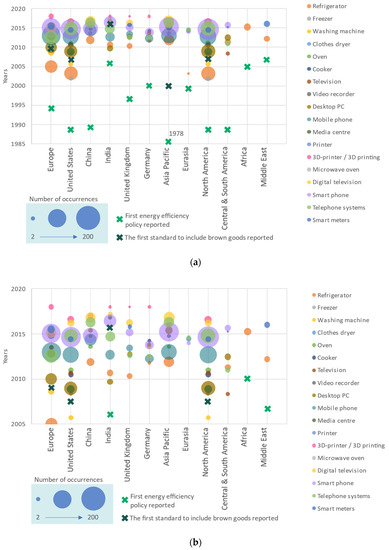
Figure 10.
Average publications year and number of occurrences of the different appliances in each studied country/region. Data from the Scopus query. The green crosses indicate the first appliance efficiency standard or policy implemented in each country/region. The dark green crosses indicate the first appliance efficiency standard or policy that includes brown goods appliances. Data obtained from the IEA policies database [46], (a) range of years from 1985 to 2020, (b) year range from 2005 to 2020.
Energy efficiency standards and labeling (EES&L) started in the 1970s and today operate in more than 120 countries worldwide for more than 100 different types of appliances and equipment [39]. Moreover, according to the IEA, and based on global data from countries with EES&L programs, the average energy efficiency of new major appliances in these countries has increased by two to three times the underlying technology improvement rate. This has resulted in energy savings of 10 to 30% over 15 to 20 years in the stock of most regulated products in all countries. In countries with strong regulations and long-standing programs that are regularly updated, the contribution was much greater, reducing the electricity consumption of many appliances by more than 50% [3]. The countries with larger EES&L programs are the United States, China, the EU, and Australia.
The above indicates that energy efficiency policies were introduced in countries with different timeframes ranging from 1978 to the present day. This study analyses how the policies and standards in place have encouraged research in the field of appliances and vice versa. Figure 10 presents the number of occurrences of a term (the name of a studied appliance) appearing per average year of publication and per country, according to the references obtained from the Scopus search. The figure shows that the most intensive research carried out was after 2010. The results obtained are consistent with Figure 8b, with refrigerators and freezers being the first appliances to be studied in the scientific literature, and 3D printers, smart meters, and smartphones the most recent ones.
The trend in the graph indicates that the first regions/countries to establish policies on appliance efficiency are the ones that first started to publish on this topic and the ones with the highest overall number of publications (with the exception of Central and South America). Surprisingly, the first country to establish energy efficiency policies in appliances was Japan in 1978 with the Energy Efficiency Act (in force). Contrary to the trend, only 69 documents published by this country were captured in the bibliometric search of this study.
North American and European regions were next to publish on the energy efficiency of appliances. Indeed, this correlates with the legislation enforced. In the case of North America, the first appliance efficiency standard was implemented in the United States in 1987 (“National Appliance Energy Conservation Act” still in force) [40], followed by Canada in 1995 (still in force) [41]. However, these two standards do not cover the Brown goods categories in Table 2. Initiatives such as the energy star [42] created in 1992 have helped as sources of information to make well-informed purchasing appliance decisions. However, compliance with this label is not mandatory for appliance manufacturers. Therefore, the first standard in North America to include brown goods was implemented in 2006 [43]. In the case of North America, it is interesting to highlight that the policies were implemented within a time span of 5 to 15 years before the more intensive research on the appliances of the policies’ scope.
The first program developed in Europe related to the energy efficiency of appliances was in 1975 in France, with the Existing Buildings Programmes [44]. However, the first regulation established within Europe with a direct target on appliances was in Spain in 2001 [45]. This regulation was limited only to the field of household appliances, it was not until 2010 that it was amended, enlarging the scope of application to all energy-related products, and whose use may have either a significant direct or indirect impact on energy consumption. The countries with the most publications in the region (United Kingdom, Germany) show a similar trend to the results for the region. There is a difference of about 10 years between the first policies and the core of scientific publications.
The Asia Pacific region shows that the first appliance efficiency policies were applied in the region in 1978, and the first to include brown goods in 2000. The core of research in this region was from 2011 to 2016, which represents a gap of more than three decades between the first policies and the most intensive research work. On closer analysis, these leading policies were implemented in Japan, which accounts for only 9% of the region’s publications. When analyzing the countries with the most publications in the region, China with 40% of the publications shows similar behavior to North America and Europe with a difference of 15 years between the first policies and the most intensive research work. On the other hand, India with 23% of the publications in the Asia Pacific region shows a great synergy between policy and research. With core research on appliances only three years after the implementation of the first policies, and even in the case of brown goods, the core research of several appliances takes place before the first policies which include it.
Eurasia, Central and South America, Africa, and the Middle East were the regions with the fewest publications, accounting for only 13% of the publications captured in this study. All four regions showed a similar trend with policies being implemented between 5 and 10 years earlier than the average publication. The exception to this was the Central and South America region, with the first policies implemented in Brazil in 1988, 20 years earlier than the average publications in the region.
Generally speaking, there is a 3- to 30-years gap between the establishment of the first standards or policies in the different regions and the core of publications in these regions. However, there are countries such as India that stand out for a good relationship between publications and policies, showing a quick response of the scientific community to the policies in place.
Furthermore, this trend seems to be changing as the most recent studies on improving the efficiency of appliances focus on brown goods Figure 8b, contrary to the low coverage of current policies in this category of appliances.
Author Contributions
Conceptualization, D.V. and L.F.C.; methodology, D.V., E.B. and L.F.C.; software, D.V.; validation, L.F.C.; formal analysis, D.V.; investigation, D.V. and E.B.; resources, L.F.C.; data curation, L.F.C.; writing—original draft preparation, D.V.; writing—review and editing, E.B. and L.F.C.; visualization, D.V.; supervision, L.F.C.; project administration, L.F.C.; funding acquisition, L.F.C. All authors have read and agreed to the published version of the manuscript.
Funding
This work was partially funded by the Ministerio de Ciencia, Innovación y Universidades de España (RTI2018-093849-B-C31—MCIU/AEI/FEDER, UE) and by the Ministerio de Ciencia, Innovación y Universidades—Agencia Estatal de Investigación (AEI) (RED2018-102431-T). This work is partially supported by ICREA under the ICREA Academia programme.
Institutional Review Board Statement
Not applicable.
Informed Consent Statement
Not applicable.
Data Availability Statement
Data are available upon request to the corresponding author.
Acknowledgments
The authors would like to thank the Catalan Government for the quality accreditation given to their research group GREiA (2017 SGR 1537). GREiA is a certified agent TECNIO in the category of technology developers from the Government of Catalonia. This work is partially supported by ICREA under the ICREA Academia programme.
Conflicts of Interest
The authors declare no conflict of interest.
References
- Elavarasan, R.M.; Pugazhendhi, R.; Irfan, M.; Mihet-Popa, L.; Khan, I.A.; Campana, P.E. State-of-the-art sustainable approaches for deeper decarbonization in Europe–An endowment to climate neutral vision. Renew. Sustain. Energy Rev. 2022, 159, 112204. [Google Scholar] [CrossRef]
- IEA. Global Status Report for Buildings and Construction 2019; IEA: Paris, France, 2019. [Google Scholar]
- IEA. International Energy Agency Appliances and Equipment; IEA: Paris, France, 2021. [Google Scholar]
- Lucon, O.; Ürge-Vorsatz, D.; Zain Ahmed, A.; Akbari, H.; Bertoldi, P.; Cabeza, L.F.; Eyre, N.; Gadgil, A.; Harvey, L.D.D.; Jiang, Y.; et al. Buildings. In Climate Change 2014: Mitigation of Climate Change; Contribution of Working Group III to the Fifth Assessment Report of the Intergovernmental Panel on Climate Change; Cambridge University Press: New York, NY, USA, 2014. [Google Scholar]
- OECD. Achievements of Energy Efficiency Appliance and Equipment Standards and Labelling Programmes; OECD: Paris, France, 2021; ISBN 9789264719361. [Google Scholar]
- International Energy Agency. Available online: www.iea.org (accessed on 20 February 2022).
- Cabeza, L.F.; Ürge-Vorsatz, D.; Ürge, D.; Palacios, A.; Barreneche, C. Household appliances penetration and ownership trends in residential buildings. Renew. Sustain. Energy Rev. 2018, 98, 1–8. [Google Scholar] [CrossRef]
- Martín-Martín, A.; Orduna-Malea, E.; Thelwall, M.; Delgado López-Cózar, E. Google Scholar, Web of Science, and Scopus: A systematic comparison of citations in 252 subject categories. J. Informetr. 2018, 12, 1160–1177. [Google Scholar] [CrossRef] [Green Version]
- Van Eck, N.J.; Waltman, L. Software survey: VOSviewer, a computer program for bibliometric mapping. Scientometrics 2010, 84, 523–538. [Google Scholar] [CrossRef] [Green Version]
- IEA—International Energy Agency. IEA Regions. Available online: https://www.iea.org/countries (accessed on 24 February 2022).
- UN—United Nations. 2019 Revision of World Population Prospects; UN: New York, NY, USA, 2020. [Google Scholar]
- Putra, G.D.; Pratama, A.R.; Lazovik, A.; Aiello, M. Comparison of energy consumption in Wi-Fi and bluetooth communication in a Smart Building. In Proceedings of the 2017 IEEE 7th Annual Computing and Communication Workshop and Conference (CCWC), Las Vegas, NV, USA, 9–11 January 2017; pp. 1–6. [Google Scholar] [CrossRef]
- Sarrafzadeh Javadi, F.; Saidur, R. Thermodynamic and Energy Efficiency Analysis of a Domestic Refrigerator Using Al2O3 Nano-Refrigerant. Sustainability 2021, 13, 5659. [Google Scholar] [CrossRef]
- Kelényi, I.; Nurminen, J.K. Bursty content sharing mechanism for energy-limited mobile devices. In Proceedings of the 4th ACM Workshop on Performance Monitoring and Measurement of Heterogeneous Wireless and Wired Networks—PM2HW2N ’09, Tenerife, Spain, 26 October 2009; ACM Press: New York, NY, USA, 2009; pp. 216–223. [Google Scholar]
- Ou, Z.; Dong, S.; Dong, J.; Nurminen, J.K.; Ylä-Jääski, A.; Wang, R. Characterize energy impact of concurrent network-intensive applications on mobile platforms. In Proceedings of the 8th ACM International Workshop on Mobility in the Evolving Internet Architecture—MobiArch ’13, 4 October 2013; Miami, FL, USA; ACM Press: New York, NY, USA, 2013; p. 23. [Google Scholar]
- Ajina, A.; Sakthidharan, G.R.; Miskin, K.M. Study of Energy Efficient, Power Aware Routing Algorithm and Their Applications. In Proceedings of the 2010 Second International Conference on Machine Learning and Computing, Bangalore, India, 9–11 February 2010; pp. 288–291. [Google Scholar] [CrossRef]
- Xiang, S.; Tang, J.; Zhang, W. Energy-efficient collaborative sensing with mobile phones. In Proceedings of the 2012 Proceedings IEEE INFOCOM, Orlando, FL, USA, 25–30 March 2012; pp. 1916–1924. [Google Scholar] [CrossRef]
- Liu, X.; Yang, Q.; Luo, J.; Ding, B.; Zhang, S. An energy-aware offloading framework for edge-augmented mobile RFID systems. IEEE Internet Things J. 2019, 6, 3994–4004. [Google Scholar] [CrossRef]
- Arshad, R.; Zahoor, S.; Shah, M.A.; Wahid, A.; Yu, H. Green IoT: An investigation on energy saving practices for 2020 and beyond. IEEE Access 2017, 5, 15667–15681. [Google Scholar] [CrossRef]
- Iezzi, B.; Ankireddy, K.; Twiddy, J.; Losego, M.D.; Jur, J.S. Printed, metallic thermoelectric generators integrated with pipe insulation for powering wireless sensors. Appl. Energy 2017, 208, 758–765. [Google Scholar] [CrossRef]
- Das, R.B.; Bozdog, N.V.; Bal, H. Cowbird: A Flexible Cloud-Based Framework for Combining Smartphone Sensors and IoT. In Proceedings of the 2017 5th IEEE International Conference on Mobile Cloud Computing, Services, and Engineering (MobileCloud), San Francisco, CA, USA, 6–8 April 2017; pp. 1–8. [Google Scholar] [CrossRef]
- Wang, Y.; Moore, D.; Lennon, T.; Cooke, G.M. Fire Resistance of Steel-Framed Multi-Storey Buildings. In Advances in Steel Structures (ICASS ’96), Proceedings of the International Conference on Advances in Steel Structures, Hong Kong, China, 11–14 December 1996; Chan, S.L., Teng, J.G.B.T.-A., Eds.; Elsevier: Oxford, UK, 1996; pp. 287–293. ISBN 978-0-08-042830-7. [Google Scholar]
- Hausherr, C.; Petersen, S.; Hüls, W.; Albers, J. Primary energy efficiency potentials of district heat driven refrigeration systems. Energy Rep. 2021, 7, 79–87. [Google Scholar] [CrossRef]
- Zhang, Q.; Fu, L.; Li, L.; Di, H. The Energy Efficiency and Economic Feasibility Analysis of the Distributed Absorption Cooling Combined with District Heating System. In Proceedings of the ASME 2009 3rd International Conference on Energy Sustainability, San Francisco, CA, USA, 19–23 July 2009; Volume 2, pp. 49–55. [Google Scholar]
- Petersen, S.; Hausherr, C.; Hüls, W.; Paitazoglou, R.; Albers, J. Efficient absorption cooling for low district heating return temperatures. Energy Rep. 2021, 7, 88–96. [Google Scholar] [CrossRef]
- Pieper, H.; Kirs, T.; Krupenski, I.; Ledvanov, A.; Lepiksaar, K.; Volkova, A. Efficient use of heat from CHP distributed by district heating system in district cooling networks. Energy Rep. 2021, 7, 47–54. [Google Scholar] [CrossRef]
- Morales-Fuentes, A.; Ramírez-Hernández, H.G.; Méndez-Díaz, S.; Martínez-Martínez, S.; Sánchez-Cruz, F.A.; Silva-Romero, J.C.; García-Lara, H.D. Experimental study on the operating characteristics of a display refrigerator phasing out R134a to R1234yf. Int. J. Refrig. 2021, 130, 317–329. [Google Scholar] [CrossRef]
- Kasinathan, D.; Kumaresan, V. Study on the effect of inclusion of thermal energy storage unit in the energy performance of a household refrigerator. Heat Mass Transf. 2021, 57, 1753–1761. [Google Scholar] [CrossRef]
- Cui, Y.; Qiao, J.; Song, B.; Wang, X.; Yang, Z.; Li, H.; Dai, W. Experimental study of a free piston Stirling cooler with wound wire mesh regenerator. Energy 2021, 234, 121287. [Google Scholar] [CrossRef]
- Ward, D.O.; Clark, C.D.; Jensen, K.L.; Yen, S.T.; Russell, C.S. Factors influencing willingness-to-pay for the ENERGY STAR® label. Energy Policy 2011, 39, 1450–1458. [Google Scholar] [CrossRef]
- Buonomano, A.; Calise, F.; Palombo, A.; Vicidomini, M. Energy and economic analysis of geothermal–solar trigeneration systems: A case study for a hotel building in Ischia. Appl. Energy 2015, 138, 224–241. [Google Scholar] [CrossRef]
- Gao, C.; Wolff, S.; Wang, S. Eco-friendly additive manufacturing of metals: Energy efficiency and life cycle analysis. J. Manuf. Syst. 2021, 60, 459–472. [Google Scholar] [CrossRef]
- Giudice, F.; Barbagallo, R.; Fargione, G. A Design for Additive Manufacturing approach based on process energy efficiency: Electron beam melted components. J. Clean. Prod. 2021, 290, 125185. [Google Scholar] [CrossRef]
- Nguyen, N.D.; Ashraf, I.; Kim, W. Compact model for 3d printer energy estimation and practical energy-saving strategy. Electronics 2021, 10, 483. [Google Scholar] [CrossRef]
- Faure, C.; Guetlein, M.-C.; Schleich, J. Effects of rescaling the EU energy label on household preferences for top-rated appliances. Energy Policy 2021, 156, 112439. [Google Scholar] [CrossRef]
- Skourtos, M.; Damigos, D.; Tourkolias, C.; Kontogianni, A. Efficient energy labelling: The impact of information content and style on product choice. Energy Effic. 2021, 14, 58. [Google Scholar] [CrossRef]
- Mahlia, T.M.I.; Masjuki, H.H.; Saidur, R.; Amalina, M.A. Cost-benefit analysis of implementing minimum energy efficiency standards for household refrigerator-freezers in Malaysia. Energy Policy 2004, 32, 1819–1824. [Google Scholar] [CrossRef]
- Shen, J.; Saijo, T. Does an energy efficiency label alter consumers’ purchasing decisions? A latent class approach based on a stated choice experiment in Shanghai. J. Environ. Manag. 2009, 90, 3561–3573. [Google Scholar] [CrossRef]
- Energy Efficient End-use Equipment International Energy Agency. Achievements of Appliance Energy Efficiency Standards and Labelling Programs; A Global Assessment in 2016; IEA: Paris, France, 2016. [Google Scholar]
- Department of Energy US, Appliance and Equipment Energy Efficiency Standards. Available online: https://www.iea.org/policies/317-appliance-and-equipment-energy-efficiency-standards?region=NorthAmerica§or=Buildings&technology=Appliances&topic=Energy%20Efficiency&type=Codes%20and%20standards (accessed on 27 February 2022).
- Government of Canada, Energy Efficiency Regulations. Available online: https://www.nrcan.gc.ca/energy-efficiency/energy-efficiency-regulations/6845 (accessed on 27 February 2022).
- Energy Star. Available online: https://www.energystar.gov/ (accessed on 2 March 2022).
- United States. Appliance and Equipment Standards Program. Available online: https://www.energy.gov/eere/buildings/appliance-and-equipment-standards-program (accessed on 20 February 2022).
- France Existing Buildings Programmes. Available online: https://www.iea.org/policies/847-existing-buildings-programmes?page=22®ion=Europe§or=Buildings&topic=Energy%20Efficiency (accessed on 27 February 2022).
- IEA. Spain Labelling and Information on Energy Consumption of Domestic Use Equipment; IEA: Paris, France, 1994. [Google Scholar]
- IEA—International Energy Agency. IEA Policies Database. Available online: https://www.iea.org/policies?qs=ger&technology=Appliances®ion=MiddleEast (accessed on 2 March 2022).
Publisher’s Note: MDPI stays neutral with regard to jurisdictional claims in published maps and institutional affiliations. |
© 2022 by the authors. Licensee MDPI, Basel, Switzerland. This article is an open access article distributed under the terms and conditions of the Creative Commons Attribution (CC BY) license (https://creativecommons.org/licenses/by/4.0/).